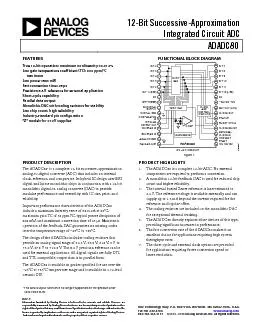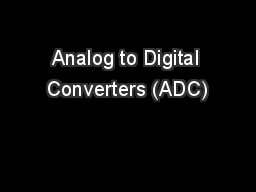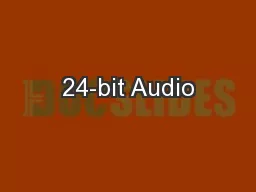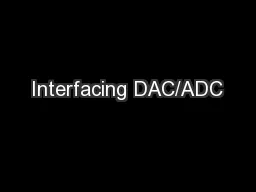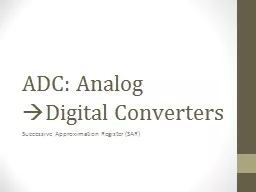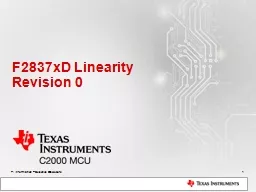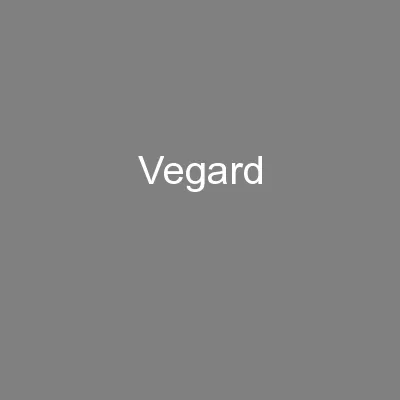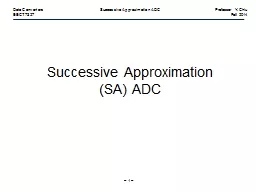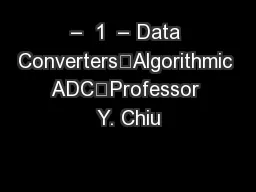PDF-12-Bit Successive-ApproximationIntegrated Circuit ADC ADADC80 ...
Author : briana-ranney | Published Date : 2015-11-06
Information furnished by Analog Devices is believed to be accurate and reliable However no 132 2 3 4 5 6 7 8 9 10 11 12 13 14 15 16 31 30 29 28 27 26 25 24 23 22 21 20 19 18 17 BIT
Presentation Embed Code
Download Presentation
Download Presentation The PPT/PDF document "12-Bit Successive-ApproximationIntegrate..." is the property of its rightful owner. Permission is granted to download and print the materials on this website for personal, non-commercial use only, and to display it on your personal computer provided you do not modify the materials and that you retain all copyright notices contained in the materials. By downloading content from our website, you accept the terms of this agreement.
12-Bit Successive-ApproximationIntegrated Circuit ADC ADADC80 ...: Transcript
Information furnished by Analog Devices is believed to be accurate and reliable However no 132 2 3 4 5 6 7 8 9 10 11 12 13 14 15 16 31 30 29 28 27 26 25 24 23 22 21 20 19 18 17 BIT 6BIT 5BIT 4BIT 3. Introduction to Mechatronics. Fall 2012. Craig . Woodin. Ali . AlSaibie. Ehsan Maleki. Background Information. What is ADC?. Conversion Process. Accuracy. Examples of ADC applications. Presenter: Craig . Ben Lester, Mike Steele, Quinn Morrison. Topics. Introduction. Why?. Types and Comparisons. Successive Approximation ADC example. Applications. ADC System in the CML-12C32 Microcontroller. Analog systems are typically what engineers need to analyze. ADCs are used to turn analog information into digital data.. CODEC. 數位電路實驗. TA: . 吳柏辰. Author. s. V1: . Trumen. V2: . johnjohnlin. Outline. Introduction to Audio Signal. Architecture Overview. Device Initialization. Device . Operation. 2. Introduction to Audio Signal. without Peripheral Controller. Dr A . Sahu. Dept of Computer Science & Engineering . IIT . Guwahati. Outline. Peripheral communications . DAC. Properties. Generic Model. Interfacing. ADC. Properties. John Milne PhD, NIBRT. 20. th. . June 2014. Ehrlich reasoned that if a compound could be made . that. selectively . targeted a disease-causing organism, . then . a toxin . for. . . that organism could be delivered along . . Digital Converters . Successive Approximation Register (SAR). Where you find ADCs. Successive Approximation Register (SAR). Sample and Hold Amplifier (SHA). Cap charges to input voltage . HOLDS it.. Revision 0. 1. Erratum. 2. This issue is fixed in revision A. ADC Linearity (Untrimmed, Rev. 0). 3. 16-Bit, Differential, ADC A INL/DNL (selected range). ADC Linearity (Untrimmed, Rev. 0). 4. 12-Bit, Differential, ADC A INL/DNL (selected range). Joa Moseng . BI - BL. Student meeting . 13.05.2013. Reliability analysis of the ADC in the BLMDP. The circuit:. Measurement Methods. The input monitoring system has two different measurement levels. . BI - BL. Student meeting . 27.05.2013. Reliability analysis of the . Input Monitor in the BLEDP. From «The new BLM system for the injector complex» . BI DAY 2012 – William . Viganò . Overview:. The circuit:. By: Ali . Mesgarani. Electrical and Computer Engineering. University of Idaho. 1. Outline. Motivation and goals . Background. New ADC topologies proposed for high speed, low power and medium resolution. EECT 7327 . Fall 2014. Successive Approximation. (SA) ADC. Successive Approximation ADC. – . 2. –. Data Converters Successive Approximation ADC Professor Y. Chiu. EECT 7327 . Fall 2014. Binary search algorithm → N*. EECT 7327 . Fall 2014. Algorithmic . (Cyclic) ADC. Algorithmic (Cyclic) ADC. – . 2. –. Data Converters Algorithmic ADC Professor Y. Chiu. EECT 7327 . Fall 2014. Input is sampled first, then circulates in the loop for N clock cycles. EE174 – SJSU. Tan Nguyen. Introduction to Data Conversion. Introduction to ADC and DAC. DAC specifications. ADC specifications. ADC/DAC Performances. Types ADC/DAC. ADC (Analog-to-Digital Converter): converts an analog signal (voltage/current) to a digital value.. Pedro . Figueiredo. pmff@synopsys.com. Topical Workshop on Electronics for Particle Physics 2015. 28. th. September 2015. ADC . performance: . Evolution. ADC architectures: . Relationships, Speed, Performance.
Download Document
Here is the link to download the presentation.
"12-Bit Successive-ApproximationIntegrated Circuit ADC ADADC80
..."The content belongs to its owner. You may download and print it for personal use, without modification, and keep all copyright notices. By downloading, you agree to these terms.
Related Documents

